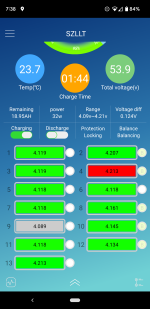DubP said:
Thanks so much for the detailed response! I think the biggest difference in pack voltages when I connected the BMS was about 0.4V (4.1-3.7), and my pack capacity is about 24Ah. Assuming those Ah work linearly across a 1V span (like 4.2 to 3.2), I think that it means it was imbalanced by 40% of the capacity, so 9.6Ah. does that make sense? Probably it was out more because I think the discharge is not linear and most of the capacity is at the higher end of the voltage span.
It's not really linear; and the actual curve depends on both the specific cell model and the load on the cell vs it's capabilities. Example:
https://lygte-info.dk/review/batteries2012/Samsung%20INR18650-25R%202500mAh%20%28Green%29%20UK.html
![Samsung%20INR18650-25R%202500mAh%20(Green)-Capacity[1].png Samsung%20INR18650-25R%202500mAh%20(Green)-Capacity[1].png](https://endless-sphere.com/sphere/data/attachments/179/179631-1ea10d36115a18fb05767b622b90d984.jpg)
I guess I'll have to cycle this battery a few times to see how out of balance it gets during use. It seems like a BMS really needs to keep up with balancing overnight if it's for a battery that gets cycles daily. I'm starting to see why a single weak cell or two could bring down a whole battery.
Improperly connected groups do it too--a broken connection to one or few cells in a group means that group doesn't ahve hte same resistance or load-bearing ability or capacity as the others. It's a pretty common problem, as is poorly-matched cells, so that different groups have different properties even when all the cells are well-connected.
A well-made pack of well-matched cells doesnt' even *need* to be balanced, especially if it is not run hard (meaning, not near it's LVC or near it's cells' max current limits). I don't even use a BMS at all on my decade-old EIG NMC 20Ah cells; they were designed to be used at high currents (100A each), in large-EV use, and I'm only using them at a fifth of that for a few seconds at a time, probably a tenth of that most of the time, and I rarely drain them nearly empty, so they stay in nearly perfect balance year after year. Occasionally I do testing of higher power systems with them that make them actually work for a living, but they dont' have to do that very often.

So for me, the cells are already pretty closely matched in characteristics (or were originally, at least), and easily capable of what I use them for without breaking a sweat.
For most packs, people choose something that can just barely do what they want it to, and *then* also go the cheapest possible route for it, which means it is not really capable of what they want, without fairly severe stress to it. So their packs get out of balance easily, and even worse as they age, and the BMS systems used are typically barely capable of dealing with the "normal" stress, much less what they actually put them thru unknowingly.
It gets worse from there.




![Samsung%20INR18650-25R%202500mAh%20(Green)-Capacity[1].png Samsung%20INR18650-25R%202500mAh%20(Green)-Capacity[1].png](https://endless-sphere.com/sphere/data/attachments/179/179631-1ea10d36115a18fb05767b622b90d984.jpg)